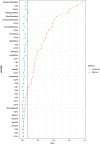Peripherally inserted central catheters have a protective role and the effect of fluctuation curve feature in the risk of bloodstream infection compared with central venous catheters: a propensity-adjusted analysis
- PMID: 35346073
- PMCID: PMC8961920
- DOI: 10.1186/s12879-022-07265-x
Peripherally inserted central catheters have a protective role and the effect of fluctuation curve feature in the risk of bloodstream infection compared with central venous catheters: a propensity-adjusted analysis
Abstract
Background: The prevention of peripherally inserted central catheters (PICC)-associated BSI and central venous catheters (CVC)-associated BSI have been a topic of national importance in China. Therefore, we aimed to explore the epidemiological characteristics of central line-associated bloodstream infection (CLABSI), and to evaluate whether PICCs were associated with a protective effect for CLABSI.
Methods: A retrospective cohort study was conducted in teaching hospital in Western China. All adult patients received a CVC or PICC during their hospital stay were included from January 2017 to December 2020. Primary endpoint was CLABSI up to 30 days after CVC or PICC placement. Propensity scores with a 2:1 match was used to account for potential confounders, and restricted cubic spline was used to visualize the risk of CLABSI at different time points during the catheterization.
Results: A total of 224687 devices (180522 PICCs and 45965 CVCs) in 24879 patients were included. The overall incidence was 1.8 CLABSIs per 1000 catheter-days. The odds ratio (OR) value increased day by day after PICC insertion, reached a relatively high point on the 4th day, and decreased from days 5 through 8. From the 9th day of intubation the OR value began to gradually increase day by day again. After covariate adjustment using propensity scores, CVCs were associated with higher risk of CLABSI (adjHR = 3.27, 95% CI 2.38-4.49) compared with PICCs.
Conclusions: PICCs have a protective role and the effect of fluctuation curve feature in CLABSI when compared to CVCs, and the first 8 calendar days after CVC insertion are the acute stage of CVC-associated BSI.
Keywords: Bloodstream infection; Central venous catheter; Peripherally inserted central catheter; Propensity score matching; Restricted cubic spline regression.
© 2022. The Author(s).
Conflict of interest statement
The authors have no competing interests to declare.
Figures




References
MeSH terms
Grants and funding
LinkOut - more resources
Full Text Sources
Medical

